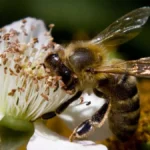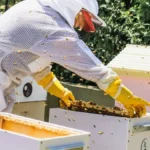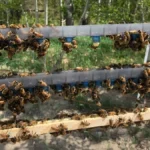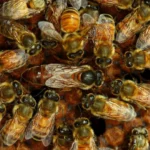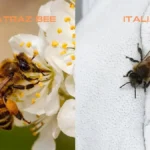How much does a queen bee cost? In this article, we have a look at how to source queen bees, ranging from free queens to expensive ones and we also evaluate the pros and cons of doing this. Remember – a good queen, like a good mother is priceless.
How To Buy A Queen Bee
There are many queen breeders who breed queens and will sell these. You can order a queen of a specific lineage with a specific set of characteristics. Mann lake beekeeping supplies (I have no affiliation or derive no benefit from mentioning this) have been around for a long time and provide some excellent equipment and have a nice selection of different queen bees here.
You will see that prices range from about $35-42 a queen. Availability is variable, and good queens sell out fast. What I like about their supply is that they have a very diverse range of queen bee genetics.
Another innovative supplier is here. I mention this site specifically because their queens are unbanked. There are all sorts of tricks we use to produce queen bees and then to have them on hand. One is to keep queens in a so-called queen bank. This means you put lots of cages in a hive and all the queens are fed by workers. Their pheromones however tend to fight with each other and the fact they are not laying eggs can cause complications to develop the longer a queen is banked.
You will see on this site the price range is somewhat lower at $19-25 dollars range.
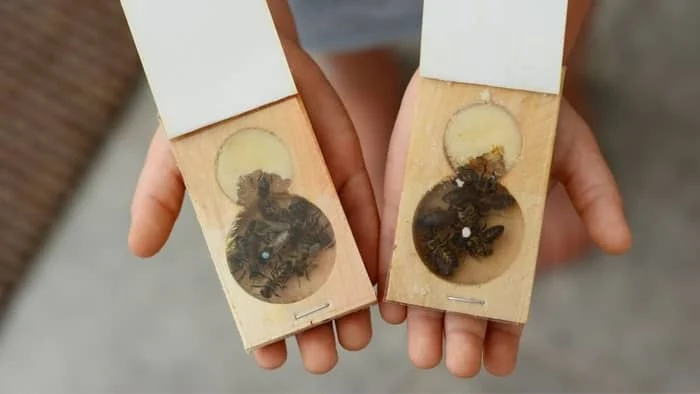
Read more about: How Long Can A Hive Be Queenless?
How To Replace A Queen
Typically you would open the hive and find your queen like this. Now you can decide whether you are going to split the hive like this. Or if you are not going to split the hive, you can just kill the old queen and replace her by putting the new queen into the hive a day later. The new queen is installed in the middle of the brood nest in her queen cage. This allows the workers to get to know her and her smell before she emerges. If you do not do this they will just kill her and you have lost $19-42 dollars.
Let’s Think A Bit More About Queens
The Primary Reproductive In The Hive
The queen bee is basically the mother in the hive. Her function is to lay a lot of eggs, the majority of which will be workers and a few will be drones. Drones are important for diversity, and we will go into that in a bit.
A queen goes on mating flights when she emerges from her queen cell. She stores the sperm from these mating flights for the rest of her life, and the workforce she produces is the offspring of these matings.
The drones she produces will be derived entirely from her DNA – hence she produces basically two types of drones with a bit of shuffling in their DNA, but essentially quite a limited genetic base.
If this queen were to lay eggs to produce more queens, she produces eggs which are a combination of her DNA plus one of the 40-60 drones she mated with. So she can produce quite a lot of variation in her daughter queens.
If You Buy A Queen…
If you buy a queen, you are buying reproductive potential from a catalog. This is all good and well until you imagine trying to start a human family this way. It can work, and there are many examples where it does. But generally, a good way to get in a fight is to call somebody else’s mother a derogatory term relating to the sale of reproductive services.
Commercial Beekeeping Versus Backyard Beekeeping
Commercial Standardised Agriculture
If we look at industrial commercial beekeeping, people need consistent reliable beehives which perform in a similar fashion. In agriculture, it is the same. Commercial large-scale farmers cannot afford the variability of genetic diversity in crops. Orchards tend to be monocultures of one or two cloned trees. Fields of annual crops tend to be from specially produced seeds that have limited variability.
This allows for bulk production of uniform products that can be mechanically harvested and marketed globally. A Fuji apple from South Africa, Chile, or China will basically be a Fuji apple. It is the same tree just grown in different places. It is literally a clone.
Backyard Agriculture
When we grow anything in our backyards for food or food services the objectives are different to industrial agriculture. If you want sweetcorn that is standard buy it at the shop. If you want weird and wonderful heirloom sweetcorn that is really sweet, cool, and special, grow and harvest it in your backyard. Use heirloom seeds. Build diversity in your backyard and keep the best seeds for next year. Your plants adapt to your garden and climate this way.
Backyard Small Scale Beekeeping
If you start beekeeping, try and buy queens in from a few different suppliers. Bring in diversity, and then let your queens thrive and from here my advice is always to try and grow your own. Backyard beekeeping allows us to build up small pockets of genetic diversity in bees that are adapted to an area.
If you were for instance to start off with a few bought Italian, Carnolian, and Russian queens in your area, you have a huge genetic starting diversity. These queens are bought, but when they requeen, they will produce queens that are quite diverse, who will then mate with drones that are from the three starting populations. The bees will now produce more diverse offspring and over time, genetic traits in these three groups will be selected that work best in your area.
If you have other backyard small-scale beekeepers doing similar things nearby, you start pooling genetic resources and localizing your genetics.
The Backyard and Small scale Beekeepers Are The Custodians Of Genetic Diversity
As a backyard beekeeper, if you find you have a genetically diverse hive that really does well it is actually a great idea to contact a commercial queen breeder and say you have a good locally adapted strain. The breeder may come and take a few eggs and use these to evaluate your locally adapted strain. This could end up being a new commercial strain, and in this way, you contribute to building genetic diversity, disease resistance, and adaptability into our honey bee genetic resource.
Genetics are a gift – we inherit these from previous generations and we build on them. The more diversity we have in genetics, the more chances we have of exceptional offspring. Inbreeding produces conformity, and conformity is mediocrity. There are always times when mediocrity is valuable, but in life exceptional is what we strive for. Mediocrity struggles to produce exceptionalism.
As a backyard beekeeper, if you produce a super queen, that can help industrial agriculture thrive, you have done your bit for food security for the masses.
A good queen, like a good mother, is priceless, however. If anybody ever calls one of my queen bees a ho, I will knock their teeth out.
We hope this article gave you a fresh perspective on the importance of genetic diversity in your beehives and how you can use this to do your bit to make our important bees more sustainable and diverse. Please share if this made you think – and debate the ideas here. I may be completely wrong in some of the theories, but when we debate we think, and when we think we stop being mediocre.
Read more about: Do Queen Bees Leave The Hive?

Dr. Garth A. Cambray is a Canadian/South African entrepreneur and beekeeper with 28 years of experience in apiculture and specializes in adding value to honey. His Ph.D. research developed a new advanced continuous fermentation method for making mead that has resulted in a number of companies globally being able to access markets for mead. His company, Makana Meadery, exports honey mead to the USA where it is available to discerning connoisseurs. He has also developed technologies to commercially manufacture organic honey vinegar in Zambia for export globally. He holds a few patents globally in the ethanol industry and believes in technology and knowledge transfer for human development and environmental sustainability. One of his proudest achievements is the fact that the wind farm he started at one of his old apiary sites has essentially made his hometown carbon neutral.

